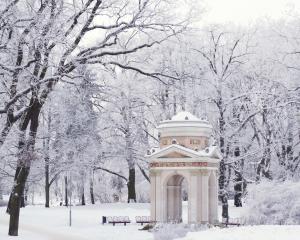One of Canterbury's finest gardens is Ohinetahi, on Banks Peninsula, designed by retired architect Sir Miles Warren.
Architects love straight lines and Sir Miles Warren (80) is no exception.
Ranked as one of New Zealand's foremost formal gardens, Ohinetahi, at Governors Bay on Banks Peninsula, was created by Sir Miles, his sister Pauline Trengrove and her husband, John.
The lineal design perfectly complements the stone house built between 1863 and 1867 by Thomas Henry Potts (1824-88), who had bought the land from the man responsible for the Lyttelton railway tunnel, Canterbury pioneer William Sefton Moorhouse.
The timber wing of the house was built for Moorhouse, "so it is really two houses", Sir Miles explains.
Potts' family had made a fortune from small arms and, having arrived in New Zealand with 40,000 - estimated to have the buying power of at least $200 million today - the man termed our first conservationist was well-placed to follow his preferred occupation of naturalist-nurseryman.
With six gardeners, he created a 4ha garden and some of the trees he planted still stand, among them a quince and variegated elm.
Sir Miles believes a huge lancewood (Pseudopanax crassifolium) is a remnant of the area's original bush.
By the early 1970s, when Sir Miles bought the property, all that was left of the garden was the lawn and the remnants of a ruined orchard with six Burbank plums.
The house was nearly derelict, and such was its state that the local council refused to give a permit for building work and recommended demolition.
The wily new owner then applied successfully for a permit for a garage and used it as the basis for restoration of the house.
"Two carpenters worked for two years and we were the general labourers," Sir Miles recalls.
In 1974, work began on the garden.
A busy, high-profile architect - the Christchurch Town Hall, New Zealand Chancery in Washington and the Michael Fowler Centre in Wellington among his many commissions - Sir Miles had always loved gardening and welcomed the chance to do what he called "something amateur" for relaxation.
Don't be fooled by the word amateur: everything at Ohinetahi has been designed and executed to the highest professional standards, from the pleached hornbeam hedges and placement of statuary to the elegant Red Garden, doubtless the inspiration for "I See Red", which won gold at the Ellerslie International Flower Show in March.
The main garden is laid out formally along two intersecting axes, with narrow vistas between the hedges and clever use of unobtrusive terracing to maximise the number of flat planes essential for the formal style.
Four of the Burbank plums were retained to frame the view from the rose garden towards the herbaceous border.
The herbaceous beds are masterpieces, a skilful blend of textures and colours, with scarlet highlights in a colour scheme dominated by pink and mauve flowers and plummy foliage.
The ogee gazebo at the far end gives enough height to link this area to the tall trees behind and, beyond them, the bush-covered Port Hills.
Viewed from the tower, from which the clipped box hedges and brick paths can best be appreciated, the walled Red Garden is another delight in formality.
The centrepiece is an old stone font, one of numerous salvaged stone items in the garden.
Others include a finial from First Church, Dunedin.
The capital in the potager was made for the old Parliament building but could not be used, "so when I retired, my partners - rather tongue-in-cheek - gave it to me", Sir Miles says.
Beyond the formal gardens, a gully divides the property.
It is crossed by a swingbridge from which moisture-loving plants can be viewed, including Ligularia - "the thugs of the garden", Sir Miles dubs them as he skips across the bridge.
On the other side is a contrasting world, a bank of swirling grasses and modern art, including an Andrew Drummond wind sculpture that makes a virtue out of the breezes that push up from Lyttelton Harbour.
Straight lines could not work here but the essence is the same: masterful planning, well-chosen plants and careful siting of works of art, all delivered with the exuberance of its creators.
"If you have fun making a garden, you hope it will brush off on the visitors," Sir Miles says.
Ohinetahi, Teddington Rd, Governors Bay, Christchurch, is open from mid-September to the end of March on weekdays between 10am and 4pm; weekends by appointment.
Admission is $10 per person (no children or dogs permitted).












